Evolutionary developmental biology
Evolutionary developmental biology (informally, evo-devo) is a field of
The field grew from 19th-century beginnings, where
The field is composed of multiple core evolutionary concepts. One is
New
History
Early theories
Philosophers began to think about how animals acquired form in the
Recapitulation
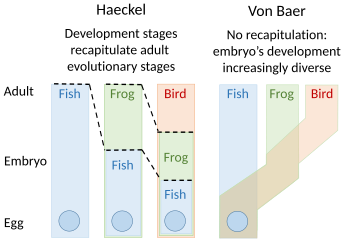
A recapitulation theory of evolutionary development was proposed by Étienne Serres in 1824–26, echoing the 1808 ideas of Johann Friedrich Meckel. They argued that the embryos of 'higher' animals went through or recapitulated a series of stages, each of which resembled an animal lower down the great chain of being. For example, the brain of a human embryo looked first like that of a fish, then in turn like that of a reptile, bird, and mammal before becoming clearly human. The embryologist Karl Ernst von Baer opposed this, arguing in 1828 that there was no linear sequence as in the great chain of being, based on a single body plan, but a process of epigenesis in which structures differentiate. Von Baer instead recognized four distinct animal body plans: radiate, like starfish; molluscan, like clams; articulate, like lobsters; and vertebrate, like fish. Zoologists then largely abandoned recapitulation, though Ernst Haeckel revived it in 1866.[3][4][5][6][7]
Evolutionary morphology
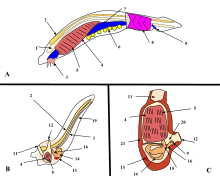
From the early 19th century through most of the 20th century,
19th century zoology thus converted
In 1917,
In 1952,
The modern synthesis of the early 20th century
In the so-called modern synthesis of the early 20th century, between 1918 and 1930 Ronald Fisher brought together Darwin's theory of evolution, with its insistence on natural selection, heredity, and variation, and Gregor Mendel's laws of genetics into a coherent structure for evolutionary biology. Biologists assumed that an organism was a straightforward reflection of its component genes: the genes coded for proteins, which built the organism's body. Biochemical pathways (and, they supposed, new species) evolved through mutations in these genes. It was a simple, clear and nearly comprehensive picture: but it did not explain embryology.[9][19] Sean B. Carroll has commented that had evo-devo's insights been available, embryology would certainly have played a central role in the synthesis.[20]
The evolutionary embryologist
The lac operon
In 1961,
The birth of evo-devo and a second synthesis
In 1977, a revolution in thinking about evolution and developmental biology began, with the arrival of
Later, more specific similarities were discovered: for example, the
The control of body structure
Deep homology
Roughly spherical eggs of different animals give rise to unique morphologies, from jellyfish to lobsters, butterflies to elephants. Many of these organisms share the same structural genes for body-building proteins like collagen and enzymes, but biologists had expected that each group of animals would have its own rules of development. The surprise of evo-devo is that the shaping of bodies is controlled by a rather small percentage of genes, and that these regulatory genes are ancient, shared by all animals. The giraffe does not have a gene for a long neck, any more than the elephant has a gene for a big body. Their bodies are patterned by a system of switching which causes development of different features to begin earlier or later, to occur in this or that part of the embryo, and to continue for more or less time.[8]
The puzzle of how embryonic development was controlled began to be solved using the fruit fly Drosophila melanogaster as a model organism. The step-by-step control of its embryogenesis was visualized by attaching fluorescent dyes of different colours to specific types of protein made by genes expressed in the embryo.[8] A dye such as green fluorescent protein, originally from a jellyfish, was typically attached to an antibody specific to a fruit fly protein, forming a precise indicator of where and when that protein appeared in the living embryo.[43]
Using such a technique, in 1994
Gene toolkit
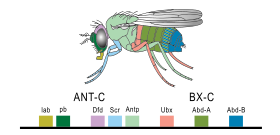
A small fraction of the genes in an organism's genome control the organism's development. These genes are called the developmental-genetic toolkit. They are highly conserved among
The embryo's regulatory networks
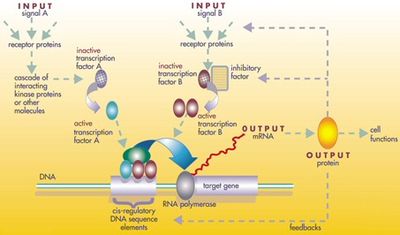
The protein products of the regulatory toolkit are reused not by duplication and modification, but by a complex mosaic of
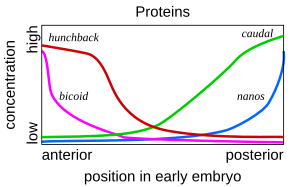
Such a cascading regulatory network has been studied in detail in the
The Bicoid, Hunchback and Caudal proteins in turn regulate the transcription of gap genes such as giant, knirps, Krüppel, and tailless in a striped pattern, creating the first level of structures that will become segments.[37] The proteins from these in turn control the pair-rule genes, which in the next stage set up 7 bands across the embryo's long axis. Finally, the segment polarity genes such as engrailed split each of the 7 bands into two, creating 14 future segments.[53][54]
This process explains the accurate conservation of toolkit gene sequences, which has resulted in deep homology and functional equivalence of toolkit proteins in dissimilar animals (seen, for example, when a mouse protein controls fruit fly development). The interactions of transcription factors and cis-regulatory elements, or of signalling proteins and receptors, become locked in through multiple usages, making almost any mutation deleterious and hence eliminated by natural selection.[20]
The mechanism that sets up every
The origins of novelty
Among the more surprising and, perhaps, counterintuitive (from a
Variations in the toolkit
Variations in the toolkit may have produced a large part of the morphological evolution of animals. The toolkit can drive evolution in two ways. A toolkit gene can be expressed in a different pattern, as when the beak of Darwin's
Consolidation of epigenetic changes
Evolutionary innovation may sometimes begin
Developmental bias
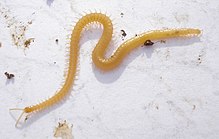
Development in specific lineages can be biased either positively, towards a given trajectory or phenotype,
Ecological evolutionary developmental biology
Ecological evolutionary developmental biology
See also
- Arthropod head problem
- Cell signaling
- Evolution & Development (journal)
- Human evolutionary developmental biology
- Just So Stories (as seen by evolutionary developmental biologists)
- Plant evolutionary developmental biology
- Recapitulation theory
Notes
- ^ Though C. H. Waddington had called for embryology to be added to the synthesis in his 1953 paper "Epigenetics and Evolution".[26]
- ^ Positive bias is sometimes called developmental drive.[74]
- ^ Spanish Wikipedia has an article on the subject: eco-evo-devo.
References
- ISBN 978-1-4088-3622-4.
- S2CID 23494485. p.516
- ^ O'Connell, Lindsey (10 July 2013). "The Meckel-Serres Conception of Recapitulation". The Embryo Project Encyclopedia. Retrieved 10 October 2016.
- ISBN 978-0-226-14374-3.
- ^ Secord 2003, p. 252–253
- ISBN 978-0-520-23693-6.
- ^ Secord 2003, p. 424, 512
- ^ a b c d e f Carroll, Sean B. "The Origins of Form". Natural History. Retrieved 9 October 2016.
Biologists could say, with confidence, that forms change, and that natural selection is an important force for change. Yet they could say nothing about how that change is accomplished. How bodies or body parts change, or how new structures arise, remained complete mysteries.
- ^ PMID 14756322.
- ISBN 978-0-8014-1319-3.
Cirripedes afford a good instance of this: even the illustrious Cuvier did not perceive that a barnacle was, as it certainly is, a crustacean; but a glance at the larva shows this to be the case in an unmistakeable manner.
- ^ Richmond, Marsha (January 2007). "Darwin's Study of the Cirripedia". Darwin Online. Retrieved 9 October 2016.
- ^ PMID 14756324.
- ISBN 978-1-4051-0345-9.
- ^ Gould 1977, pp. 221–222.
- S2CID 205076253.
- ^ Shalizi, Cosma. "Review: The Self-Made Tapestry by Philip Ball". University of Michigan. Retrieved 14 October 2016.
- S2CID 120437796.
- ^ Gribbin, John (2004). Deep Simplicity. Random House. p. 126.
- JSTOR 4086148.
- ^ S2CID 2513041.
- ISBN 978-1-107-62139-8.
- ^ Gould 1977, pp. 221–222
- PMID 16506229.
- PMID 8605997.
- ^ Adams, M. (1991). "Through the looking glass: The evolution of Soviet Darwinism". In Warren, L.; Koprowski, H. (eds.). New Perspectives in Evolution. Liss/Wiley. pp. 37–63.
- ^ Smocovitis 1996, p. 153
- PMID 13936070.
- PMID 860134.
- PMID 8605997.
- S2CID 19264907.
- PMID 10781035.
- PMID 16252267. Archived from the originalon 11 December 2012.
- S2CID 32054147.
- ^ S2CID 32648995.
- Karolinska Institutet. Retrieved 13 October 2016.
- S2CID 44396110.
Homeobox genes are found in almost all eukaryotes, and have diversified into 11 gene classes and over 100 gene families in animal evolution, and 10 to 14 gene classes in plants.
- ^ S2CID 4337658.
- S2CID 4432164.
- ^ "Eric Wieschaus and Christiane Nüsslein-Volhard: Collaborating to Find Developmental Genes". iBiology. Archived from the original on 13 October 2016. Retrieved 13 October 2016.
- PMID 16453891.
- ISBN 978-0-297-85094-6.
- PMID 9144208.
- ^ "Fluorescent Probes". ThermoFisher Scientific. 2015. Retrieved 12 October 2016.
- PMID 1575438.
- ^ PMID 9122210.
- ^ PMID 12100888.
- PMID 28347942.
- PMID 9006082.
- S2CID 4404460.
- PMID 19734295.
- PMID 9336443.
- S2CID 9530210.
- ^ ISBN 978-0-321-56976-9.
- ^ PMID 8973159.
- S2CID 4355458.
- PMID 1293230.
- PMID 36531949.
- ISBN 978-0-86542-574-3.
- ISBN 978-1-4051-1950-4.
- S2CID 12375030.
- S2CID 9652129. Archived from the original(PDF) on 17 April 2016. Retrieved 27 November 2015.
- S2CID 17226774.
- S2CID 4309833.
- S2CID 19592597.
- S2CID 10274300.
- PMID 12223397.
- S2CID 4430563.
- PMID 17494755.
- PMID 18791259.
- S2CID 154023266.
- ISBN 978-0-19-854063-2.
- ISBN 978-0-19-512235-0.
- ^ Müller, Gerd B.; Newman, Stuart A., eds. (2003). Origination of Organismal Form: Beyond the Gene in Developmental and Evolutionary Biology. MIT Press.
- ^ S2CID 41698287.
- PMID 28347942.
- PMID 12242638.
- S2CID 2371623.
- PMID 24277297.
- S2CID 116886911.
- S2CID 205486234.
Sources
- OCLC 2508336.
- ISBN 978-0-226-74410-0.
- Smocovitis, Vassiliki Betty (1996). Unifying Biology: The Evolutionary Synthesis and Evolutionary Biology. Princeton, NJ: Princeton University Press. OCLC 34411399.
External links
 Media related to Evolutionary developmental biology at Wikimedia Commons
Media related to Evolutionary developmental biology at Wikimedia Commons
